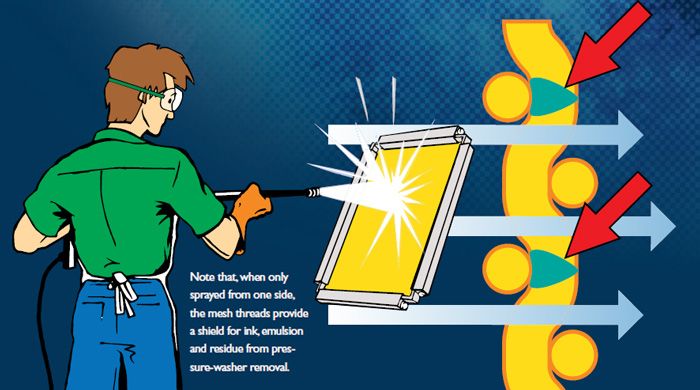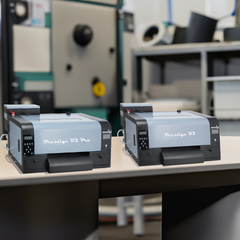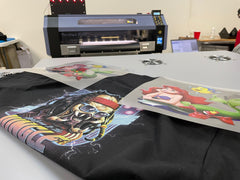A Guide to Practical Screen Printing Reclaiming
by Douglas Grigar

Screen printing reclaiming with an eye toward diminishing mesh haze, ghosts and stains? One heck of a demand! It can be done though. This article is specifically aimed at using plastisol ink, but many of the points made here are universal to any t-shirt ink system. Note, also the word diminishing. Every ink system has the ability to create results that we could interpret as staining, ghosting and haze. It is a fact of the process and you will see it even with the best of procedures and chemicals. There is no magic bullet. However, with the selection of appropriate, high-quality products, and proper application, you will go a long way toward minimizing haze, stains and ghosts.
Eliminating certain problems that are often considered reclaiming issues, but actually begins much earlier; and a few problems even start with the initial production of the screen as an assembled unit.

A Trio of Troubles: What Causes Screen Printing Haze, Ghosts, and Stains
There are three basic items that cause what could we call haze, ghosts or stains: screen printing emulsion sensitizer, water based inks and plastisol inks, and particles of old emulsion. Any of the three items can cause problems with new emulsion to be exposed onto the mesh, the quality of the stencil, and even the final desired print.
To start a conversation about cleaning and preventing stains, we need to look closely at the mesh and the mesh threads. Polyester monofilament mesh under a microscope looks like woven smooth translucent tubes (SEE IMAGE). When monofilament threads are scratched by the use of abrasives, the smooth threads will gain surface area in the scratches and create that many more areas where particles, residue and chemicals can become trapped.
While the visual effect of using an excessively strong caustic to remove staining may lead you to believe that the silk screen chemical is cleaning the mesh, it is actually damaging the mesh screen. Imagine a fresh-picked head of lettuce. If you scrub off the outside leaves of that head, have you actually cleaned it? Caustic chemicals work in a similar way: They don’t clean the mesh but rather eat away at the surface of the threads, and when rinsed with water, a thin layer of mesh thread is also rinsed away. While stripping away material from the mesh threads will take the stain with it, it shrinks the diameter of the threads weakening the mesh.
 Removing thread material with strong chemicals decreases strength and changes the thread proile (as shown, top to bottom) . . . changing the printing characteristics.
Removing thread material with strong chemicals decreases strength and changes the thread proile (as shown, top to bottom) . . . changing the printing characteristics.
Keeping your mesh tension high also helps lesson the chances of particles wedging themselves into the knuckles of the mesh. The tighter the mesh, the flatter the angle of the mesh intersections, and the lower the chance of imbedding ink and emulsion between them. The mechanics of lower-tension mesh trapping products is as interesting as it is inconsistent. Lower-tension mesh requires higher off-contact, so the squeegee forces the mesh ahead of its stroke to greater distances. Stretching the threads back and fourth across one another with excessive off-contact not only causes distortion of the image but increases the chance that ink product will be worked into and under the knuckles of the mesh.

One of the most obvious and easiest ways to eliminate problems is directly related to under-exposure. There are two facets to this problem: one exposure related and the other exposure and/or chemical in nature. For starters, and contrary to what many printers may think, under-exposed emulsion takes longer to break down in reclaim and will require more emulsion-removing acid than fully exposed emulsion.
Diazo staining is one of the most recognizable staining problems and is caused by unexposed diazo sensitizer. Obviously, the simplest solution is to not under-expose emulsions containing diazo. Diazo staining has a characteristic yellow-brown stain it leaves on polyester mesh that accumulates with each additional under-exposure. Diazo stains are easiest to spot on white or lightly dyed meshes, but negatively effect any color mesh.
Rinse the unexposed emulsion vigorously from your print areas and continue to rinse until it is completely off the mesh. Unexposed emulsion layered on the back of the stencil not only will create scumming issues but will almost guarantee diazo staining.
Locked Up Like Instant Glue
Many popular pre-sensitized emulsions used in the industry have one technical sticking point: chemical sensitivity. Pre-sensitized emulsions are available with solvent- resistance features, but this elevates the cost. Typical choices in this fast-exposing emulsion are often extremely reactive to solvents, and this sensitivity is increased when they are under exposed. The industry term most used for this chemical phenomenon is “lock-in” and, because under-exposure and the use of hot solvents is so common, this problem is widespread.
Often, when I’m demonstrating the emulsion reclaiming procedure, printers are shocked at the ease of removal when emulsion is fully exposed. Typically, the faster the on-press cleaner evaporates and the more progressively emulsion is underexposed, the more likely a chemical lock-in will result. Aerosol “screen-openers” are big culprits for emulsion lock-in and ink staining.
T-Shirt Inks and Press Washes
Plastisol inks are a particularly mild printing product and can be cleaned or removed using relatively mild cleaning products. How plastisol can become problematic and stain mesh or create ghost remnants is more a function of the type of cleaner and methods employed.
Screen Printing plastisol has a trait very useful to screen printers, as it never air-dries but must be cured using elevated heat. This trait also contributes to problems with “on-press” cleaners which fast-evaporating cleaners thin the ink, allowing the pigments to seep into the mesh knuckles before the ink can be removed. Many printers will saturate a screen with such a fast-evaporating cleaner in an attempt to wipe off all the residue before it all evaporates. Unfortunately, this only thins the ink and contributes to further staining.
Since plastisol is rather viscous, the majority of ink can easily be scraped off the screens and returned to the original container for later use. Once the majority of ink is scraped off the screen, a dry rag can be used to wipe the remaining t-shirt ink, after the dry wipe, a light spray of medium- to slow-evaporating on-press cleaner can be applied and wiped, leaving the screen mesh clean and open. Because a light spray of slow-evaporating cleaner is used and immediately removed, there is less chance for thinned ink to seep into the thread knuckles.
On-Press Cleaner vs. Plastisol Ink Wash
Some garment printers are unclear about the difference between an on-press cleaner and an ink wash. Typically, the former is faster to evaporate, while the ink wash (or ink degrader) is used off the press, prior to emulsion removal, and depends on a water wash to remove it from the screen. Adding to confusion is the fact that there are many combination products and multi-duty chemicals available. Always consult the chemical maker’s directions or contact the manufacturer directly for correct procedures for a particular product or chemical line. Always make sure the technical advisor knows your inks, emulsions and other screen printing chemicals in order to advise you on the exact match you need for your operation. Always check on local laws—and important details such as the use of a septic system—with your manufacturer and local regulatory agencies.
Under Pressure: The Use of a Pressure Washer Stencil Development & Cleaning
Use of a pressure washer for both stencil development and final cleaning can help prevent haze, stains and ghosts. A pressure washer helps remove material and can help conserve resources by quickly moving chemicals, inks and emulsion without overusing cleaning chemistry and rinse water.
While reclaiming, always use the pressure washer from both sides of the screen, when removing or stripping emulsion. Any emulsion left will want to bond to the mesh and, by spraying both sides from various angles, you will make sure that the threads do not block the spray leaving microscopic scraps of emulsion on the opposite side.
Review industry periodicals, attend trade shows and research chemical manufactures’ materials and websites for new products and innovations. No industry educator, consultant, guru or supplier can be intimately familiar with every chemical line or individual product and, because of that fact, I encourage end users to call or email manufacturers asking for detailed recommendations along with actual on-site testing, and review to find the best it.
Reprinted from Printwear Magazine November 2008 ©2008 National Business Media, Inc. All rights reserved.




